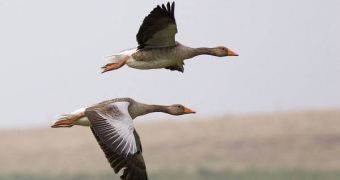New insight into how birds develop seems to point at the fact that the size of the flying creatures is not directly determined by the amount of effort they need to make in order to remain aloft, but rather by the necessity to be able to keep their feathers clean at all times. Apparently, this fact is more important than the overall size of the birds, and this line of reasoning applies to all species. Also, it seems that the effort they have to make while moulting needs to be reduced as much as possible, because it takes valuable time and resources from other activities, such as rearing chicks, mating, or migrating.
Parasitic and bacterial infections, as well as a lot of “flight hours” can severely damage the feathers, and the effort to grow new ones takes a lot from a bird. Therefore, nature must have decided that having creatures as large as the Pterosaurs, for instance, was not very efficient, in terms of species survival. In a new scientific paper, published in the open-access journal PLoS Biology, researchers from the University of Washington in Seattle, led by scientist Sievert Rohwer, present their findings after studying 43 species of birds, and the relations between their size, the length of the flight feathers, and the amount of time they use to grow new ones, Nature News reports.
“So, as birds get bigger, the rate of feather growth fails to keep up with the increase in flight-feather length, forcing larger birds to spend disproportionately more time growing their flight feathers,” Rohwer explains. According to the research, the length of birds' flight feathers is proportional to their body mass raised to the one-third power, whereas their feather growth rate is only proportional to body mass raised to the one-sixth power. As a direct result, three kilograms appears to be a limit of sorts on bird weight, although larger ones, such as albatrosses, have developed new strategies of retaining their sizes and not moulting over extended time frames.
These birds, for instance, stretch the moulting process for more than two or three years, and, as such, are able to replace their flight feathers without too much efforts. Other winged animals, for instance, change them all at once, and do not fly at all during the periods when they do this. However, the researchers say, the latter method is not too effective, as the birds can catch a lot less food, and they also cannot escape predators, if they are found in between feather sets.

 14 DAY TRIAL //
14 DAY TRIAL //